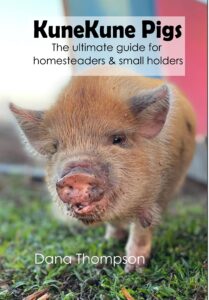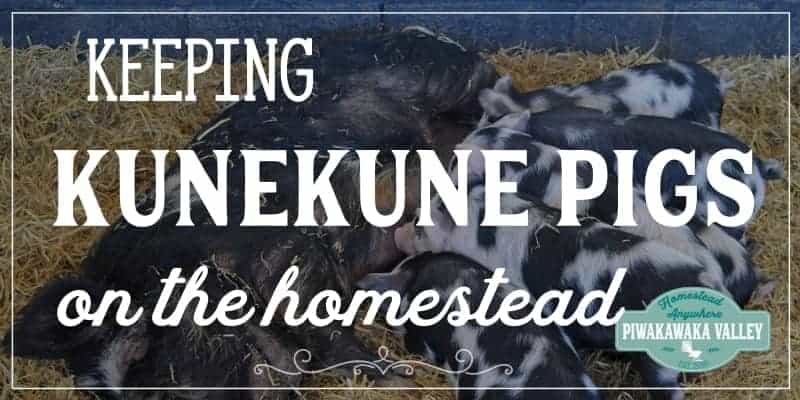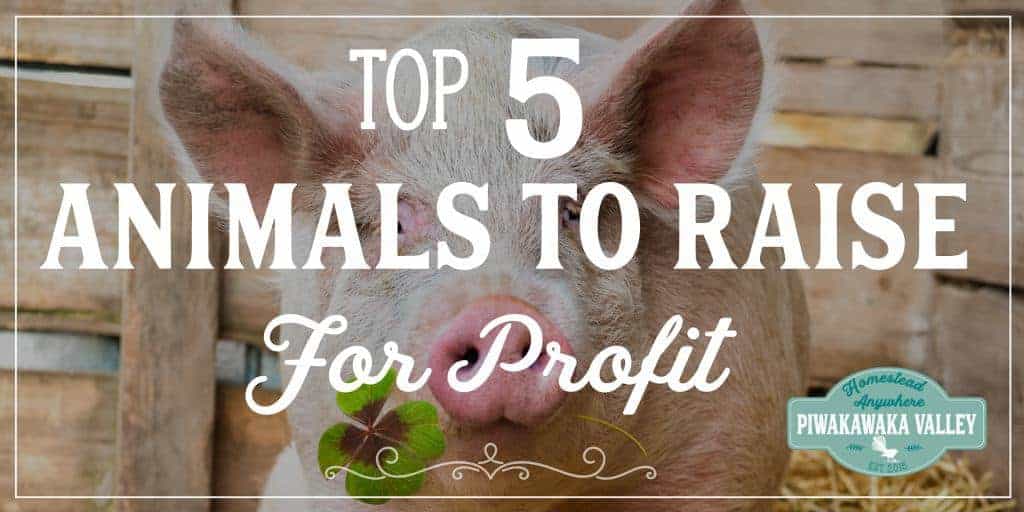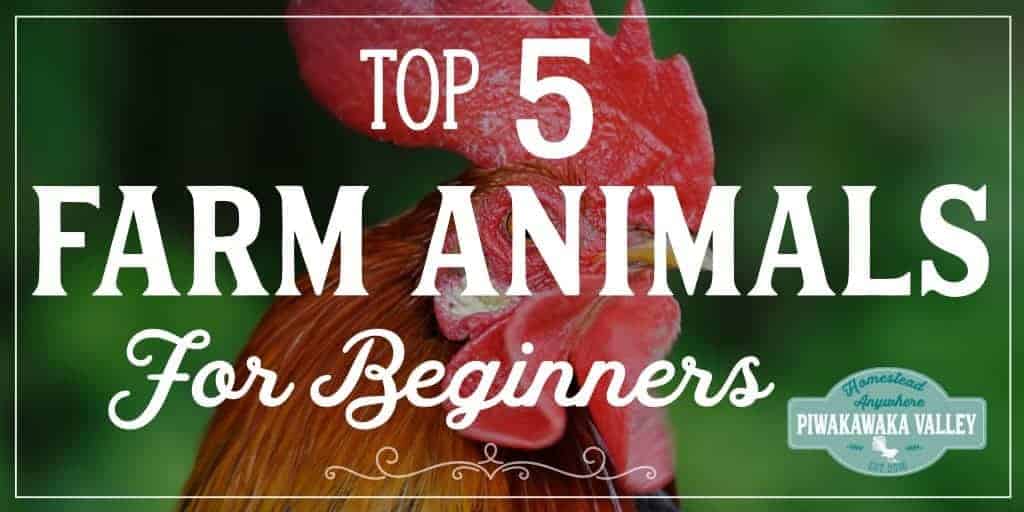This post was most recently updated on March 9th, 2021
Free-ranging heritage pig breeds have a lot to offer the homestead smallholder. That, and they are delicious. Pigs are real characters and they can be extremely productive.
Please read: This information is provided for educational purposes only and is not intended to treat, diagnose or prevent any disease. We encourage you to make your own health care decisions in partnership with a qualified health care professional.
This post contains affiliate links, this means at no extra cost to you, we make a commission from sales. Please read our Disclosure Statement
Pigs were one of the first animals to be domesticated and they now account for about 30% of today’s meat production.
Growing two weaners from 6 weeks to butcher size is the easiest way to grow your own pork. You can get them in Spring time and process them just before the cold of Winter sets in.
Pigs are very social animals, so you need to keep at least 2 at any time.
We love our Kunekune so much, and found many of the “books” available were nothing more than pamphlets or AI generated content, so I wrote my own book on raising and caring for Kunekune pigs. Check it out here.
Heritage Pig Breeds
The commercial Large White pigs are fast growers and they taste amazing. Large Whites have massive litters, but they are really bred to live in a shed, not under the hot sun, where they tend to get bad sunburn.
Heritage pig breeds are better suited to living outdoors and are great if you want to raise free range pigs. They love to forage and they prefer more grass in their diet.
Heritage pigs also don’t burn in the sun so readily, although they will still seed some shelter and shade.
Black Devon Pigs
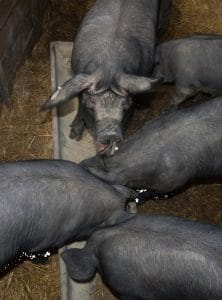
Their lovely personality may become an issue when you have to say goodbye, so be wary not to get too attached!
Black Devon sows are generally happy for you to be nearby during labor, and they don’t mind you handling their piglets.
Their meat is full of flavor and very well marbled. While they had dark hair, their actual skin is still white.
Saddle Backs or Hampshires
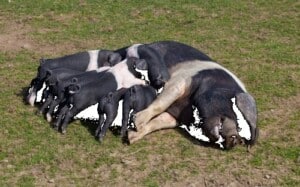
They grow fairly fast, and have very large litters – up to 18 piglets!
Hampshires have lean meat and they are particularly good for bacon and ham.
Berkshire Pigs
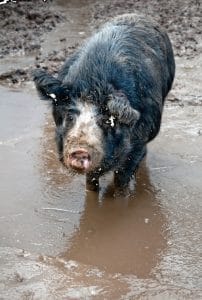
Known in Japan as Kurobuta, they have reached the status of Kobe Beef, they are known as a premium product
Berkshire pork is prized for juiciness, flavour, and tenderness, is pink-hued and heavily marbled.
Tamworth Pigs
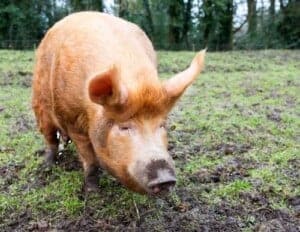
They are hardy, and excellent foragers that are well suited to outdoor life.
Tamworths produce a firm, lean meat and they are slower to mature. They are fantastic for bacon and ham.
KuneKune
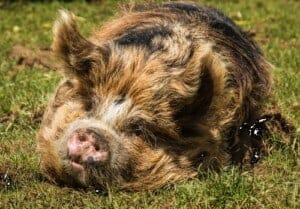
They are the only true grazing pig, and can be maintained with grass alone without supplementary feeding. An acre of grass can sustain as many as 5 kunekune.
Our kune we owned when I was growing up ate so much her eyelids got fat and she couldn’t see anymore! The word kune means fat or plump – kunekune is super plump!
Litters are usually about 7-8 piglets
They are less likely to root up the ground than other pigs, but they are smaller in size and stature, and they might just win your heart.
RELATED: Why kunekunes are great on the homestead
5 Things your Heritage Pig Needs for Free Ranging
Shelter
Heritage pigs are more hardy, but even they will need some shelter from the hot summer sun, and the wet cold days.
A good sized tree in the paddock would be enough, or else build them a shed. They will need to be able to get out of the cold winds as well.
A Wallow
Pigs love to bathe, partly cos it is fun, partly to keep the fleas away and partly as protection from the sun.
If there is naturally wet ground, the pigs will build themselves one. Otherwise it would be nice to install a hose or sprinkler on a timer, or with a pig operated switch so they can turn it on.
Water
Pigs, like any animal, need cool fresh water available at all times. Make sure the trough is sturdy and they can reach the water that is in it without falling in.
Fencing
Pigs can and will push through most standard fencing. The two best options are solid walls as they won’t attempt to push them, or an electric wire.
A hot wire 8 inches off the ground is enough to contain almost any pig.
Company
Pigs are social animals and they need company of their own kind. Pigs are more intelligent than many people think, and they need to social interactions and stimulation of another piggy.
Pigs don’t mix very well with other animals. Horses and pigs are a particularly bad combination.
Feeding your Heritage Pigs
Grass, forage, fruit and vegetables are the bulk of a free range pigs diet.
Unless you are running only kunekune, you will need some sort of supplemental feeding. The more concentrated feed the pigs get the faster they grow and reach slaughter weight.
Pigs will eat almost anything. Because of risk of disease pigs should not be fed raw meat, and any cooked meat needs to be boiled for at least 1 hour.
Milk waste is a traditional thing to raise pigs on, but be aware that too much of it will just give you fat pigs. If you store the milk waste in containers for a couple of days it will naturally sour into a kind of yogurt.
Barley is probably the best grain feed for pigs, you can either crush it or soak it in water. Fermented grains has many benefits.
You can use blood and bone meal to add some protein and nutrients to the feed.
Slaughter time with Heritage Pigs
As the pigs get older, they get bigger and more flavoursome, but also fatter and tougher.
Young pigs are best to eat as spit roasts, old ones make great sausages. Bacon and ham’s process removes the toughness, which is why baconers are usually raised until they are a bit older.
There is a point with any animal where the feed to meat conversion starts to drop and it stops being economical to keep feeding them.
Pork is usually slaughtered at around 50kg (100lb) or around 6 months old for a heritage breed pig. Baconers are usually grown until about 9 months old or about 100kg (200lb).
If you only have two pigs, the idea is you choose somewhere in the middle. It is not kind to kill one and leave the other.
In the last few weeks avoid feeding anything strong in flavor as it will affect the taste of the meat. Apples and acorns make wonderful tasting pork.
To scald a porker you will need to bath the pig in 60 degree C water immediately, but if you are doing ham or bacon, it is easier to strip the skin off.
If there is excessive back fat carve it off and render it down to lard, or add it to sausage meat.
If you want to process your pigs yourself, this is the best video I have seen on it.
Please Pin and Share

